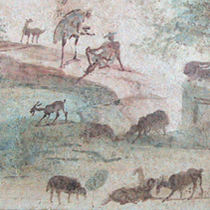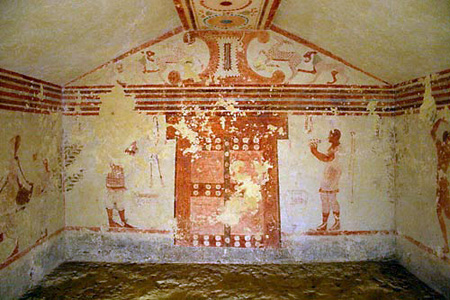 1>
1>Antecedents
Distinguishing between antecedent influences and indigenous practices is always difficult, even when the art in question is only decades old. However, there appears to be general agreement that the Romanising of Greek and Hellenistic culture was a well-established feature in Roman art, despite objections raised by influential writers such as Cato and Pliny the Elder.
In many respects the absorption of foreign culture was so well implanted on Roman soil that when Cato in the second century BC bemoaned its detrimental effect on traditional Roman art and values, so called ‘traditional’ Roman art was already substantially infused with Greek influences. Initially this occurred via indirect sources such as Etruscan and later via direct contact with artefacts brought to Rome in the form of spoils of war. Undoubtedly the presence of more experienced Greek artists in Magna Graecia (Southern Italy) and later in Rome, also had a profound effect upon the early development of Roman art. (Trendall 1989: 7) Temples such as the one dedicated in 493 BC to Ceres, Liber and Libera in Rome, were known to have used Greek architects and artists. (Pliny, Nat. Hist., XXV, 154 and XXXV, 15) In using art as a sign of moral degeneration Cato juxtaposes two tropes in which Italo-Roman’s are described as pious and restrained, whilst Greeks are characterised as hedonists. Later Roman writers such as Varro in his Rerum Rusticarum and Virgil in both the Eclogues and Georgics, further romanticised this theme in an attempt to reclaim the blissful bucolic harmony that they associated with ancient Roman agrarian communities (fig.1).
Much of our evidence for wall-painting prior to Pompeii and Herculaneum comes from ancient cultures that buried their dead in mausolea and tombs (fig.2). Non-funerary sources include Minoan sites located on and around Crete (fig.3). Since mainland Greeks normally commemorated their dead by ‘leave taking’ or epigraphic stele, very little Greek painting has come down to us via that source (fig.4). Magna Graecia, in contrast, yielded substantial amounts of ancient wall-painting, particularly Italy’s Campanian region, Anatolia in Turkey and Macedonia, North of Greece. (Maiuri 1959:9) Almost exclusively these paintings survived because they were in sealed tombs or sarcophagi. The fourth century BC Etruscan tombs at Tarquinia, north of Rome, are some of the best examples of pre-Roman wall-painting. Their trading nation status enabled them to absorb many of the stylistic features found throughout Magna Graecia, particularly amongst the Phrygians, Carians and Lydians, whom the Etruscans claimed as their forebears.
Other than the use of eschatological door motifs the tomb paintings at Traquinia have very little in common with Roman wall-painting (fig.5). They use no linear or atmospheric forms of perspective and as such are closer to the planar side elevation compositions used by the Egyptians and Minoans.
 5
5
|